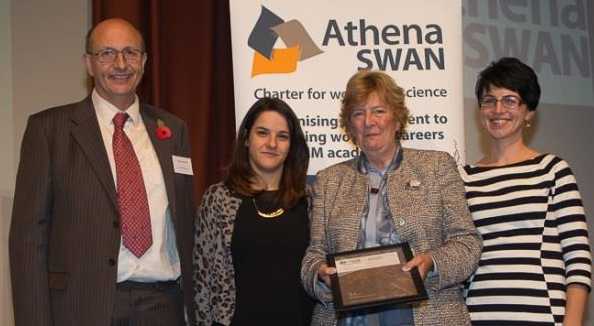The Eighth Max Perutz Prize of the European Crystallographic Association
In anticipation of receiving the 8th Max Perutz Prize of the European Crystallographic Association, Professor John R. Helliwell, Emeritus Professor of Chemistry at the University of Manchester and recent ACA Patterson Award winner, shares some reflections on his career and achievements, and the importance of crystallography.
John, could you start by giving us a brief history of your career to date?
How did you get into the field of crystallography?
Were there any major milestones along the way and key turning points?
What have been some of your own memorable and personal achievements to date?
 |
| John Helliwell receiving the Athena SWAN School of Chemistry Silver Award on behalf of the School; left to right JRH, Dr Cinzia Casirhagi, Dame Julia Higgins (Patron of Athena SWAN) and Dr Anna Valota (Chair of the School's Post Doc Forum). |
I have touched upon aspects of these earlier, and they are elaborated in my 8th Max Perutz Award acceptance lecture at the ECM29 Opening Ceremony in Rovinj, Croatia. I would also like to add something about trying to move gender equality in science forward. My DPhil supervisor was female (Dr Margaret Adams), as was her DPhil supervisor (Prof Dorothy Hodgkin OM FRS). With such a pedigree it was not immediately apparent to me that gender equality was a serious issue. When this did become clear, I very actively tried to do something about it. I became gender equality champion in my School of Chemistry in Manchester University, where I led a working group on behalf of the School towards first a Bronze and then a Silver Award of achievement from the UK’s Department of Business, Innovation and Science ‘Athena SWAN’ scheme (SWAN = Science Women’s Academic Network). The major issue is of course the widespread inequality that women experience in making their way in science. Perhaps less highlighted is that the natural talent that we train to a very high standard as graduates in chemistry (40% women) and physics (20%) and so on leads to around only 5% of professors being women. This is a massive discrepancy. We have to understand each stage of the academic career progression path, and do much better at assisting women at each hurdle. Otherwise we will continue to see this huge loss of trained talent. That is what the Athena SWAN scheme is about, a marvellous initiative of our UK Government, and I am glad to have played a role in trying to help. Crystallography as a field has a better than average performance – for instance we have seen three female IUCr Presidents. That is good, but much remains to be done.
Can we round off this interview with why you feel crystallography is so important?
People in general have a curiosity about crystals. I have taken the time and trouble to meet the public and schoolchildren in many ways: at our University School Open Days; explaining to the media our research results; giving open lectures to workers' associations and the University of the Third Age; and in schools themselves giving 'general science interest' lectures. I have even had the pleasure of delivering a Royal Institution Friday Evening Discourse, Baroness Greenfield presiding, on the topic 'Why does a lobster change colour on cooking?' I find explaining crystallography a joy. I like to start by showing people the double image effect in calcite and asking ‘how do you think that happens?' Besides natural curiosity, at the other end of the spectrum lies the utility of our discoveries as a field. The discovery of new pharmaceuticals for disease treatments is very much assisted these days by structure-based drug design, which has crystallography at its core. And then, of course, the computer is based on perfect single-crystal silicon, of which one deliberately alters the electronic properties by doping to create n- and p-type semiconductors. Probably the most famous scientific discovery of the last century was the structure of DNA, which was based on helical X-ray diffraction data from fibres of DNA – a fantastic piece of basic science laying down the basis for understanding heredity. That discovery has proved so important in modern-day genetics and in DNA fingerprinting in forensic science. I think all of these things appeal to people, right the way from natural curiosity through to the utility of science. These sorts of examples led to formal approval by the United Nations of the International Year of Crystallography 2014, which was brought about following the efforts to make the proposal in the first place of the International Union of Crystallography, under its then President Professor Sine Larsen, and the Moroccan Crystallographic Association, led by Professor Abdelmalek Thalal. This has been a marvellous event for our field and for communicating about our science. Many marvellous things have happened through the IYCr. One I especially liked was Crystallography365 ('tweeting a crystal structure a day’), led by Dr Helen Maynard-Casely and colleagues, which now features as a perpetual calendar on the IYCr legacy website.

